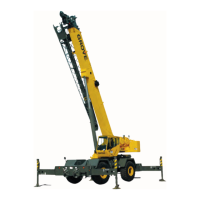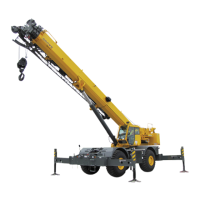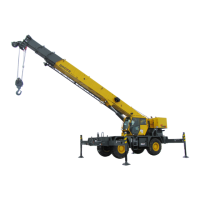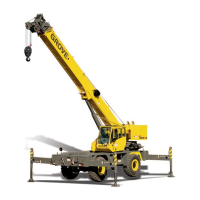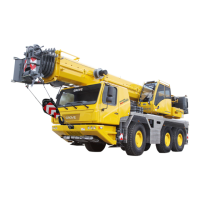BOOM RT9130E-2 SERVICE MANUAL
4-6 Published 11-22-2016, Control # 345-12
Electronic Control System
As mentioned previously, the electro-hydraulic sequencing
and synchronization of the inner mid and center mid section
telescope cylinders are controlled through a combination
RCL/boom control system electronic processor/controller,
since both systems need to sense the various section
extensions (i.e. to determine the boom length and its
configuration [sectional extension relationships] in order to
compute allowable load moment and the corresponding
allowable hook load for RCL purposes, and to close the
telescope sequencing/synchronization system feedback
control loop).
System Interfaces and Logic
The electronic system is supplied with electrical power of 12
VDC.
The electronic system collects electrical inputs from boom
length sensors that separately measure overall boom length,
and extension of the inner mid section. Since the outer mid
and fly sections are mechanically [cable-] synchronized, and
change over of hydraulic oil supply to or from the outer mid/
fly section telescope cylinder is mechanically effected by trip
valves upon full extension of the center mid section, or full
retraction of the outer mid section, it is assumed that these
sections cannot become unsynchronized. Therefore, on this
basis the computed difference between the measured boom
extension value and the measured inner mid section
extension value allows the system to infer the extension of
the center mid section.
The system also collects electrical inputs of boundary
conditions (operator selection, by switch, of “Automatic” or
Manual mode, electrical sensing, by proximity switches, of
retracted condition of the inner mid section relative to the
base section, and of the center mid section relative to the
inner mid section, and of telescope extend or retract pilot
pressure being applied). The system then produces current
controlled electrical outputs to the appropriate pilot system
proportional pressure reducing valves, allowing the pilot
pressure to shift the telescoping control valve spools
appropriately to direct oil to the inner mid or to the center mid
section telescope cylinder, according to prevailing boom
length and to the direction of motion selected.
In Automatic mode, the control system output current being
applied to the applicable valve is automatically reduced as
each section approaches a position at which the selected
telescope sequence would require it to stop and the next
section to begin to move. This causes the pilot oil pressure
being applied to the control valve spool to be proportionately
reduced according to the current, (overriding the operator’s
pilot control valve), so that the section telescoping speed
reduces smoothly before the section finally comes to rest. In
the same way the current supply to the valve controlling the
following section is initiated just before the previous section
finally comes to a halt, and rises smoothly to its regulated
value, giving a smooth acceleration of that section. This
system prevents out of sequence conditions occurring as a
result of overshoot of the section that is coming to a halt, and
also enforces a smooth transition from section to section.
An additional benefit occurs in situations in which the
operator is simultaneously operating the hoist, in order to
keep the load at a constant height while telescoping the
boom. Since telescoping speed inevitably varies from
section to section according to the bore of the cylinder, and
also whether a section is indirectly moved by a cable
extension system, the compensating speed of the hoist has
to be varied by the operator as each successive section
change occurs, so that the load does not immediately rise or
fall. The smooth changeover effect enforced by the
telescope control system allows the operator a wider band in
which to adjust compensatory speed of the hoist so that the
load can be more easily kept at a constant height.
The inner mid and center mid sections are extended by a 2-
stage cylinder, the larger diameter cylinder being the center
mid section stage. Therefore this stage has the capability to
exert higher load than the inner mid section stage, for a given
hydraulic pressure. Such loads would exceed the buckling
resistance of the smaller inner mid section stage, which in
Automatic mode is already at 75% extension before the
center mid section cylinder is actuated. For this reason, the
system provides an additional electrical output to a dual
pressure relief valve integrated in the telescope control valve
block, causing it to reduce the maximum pressure that can
be applied to the center mid section telescope cylinder, so
that the cylinder is protected from such excessive buckling
loads. The system programming always ensures that the
lower pressure is selected before the center mid section
cylinder is pressurized, and that the center mid section
cylinder is isolated or fully extended, before the higher
pressure is selected and applied to the other cylinders.
The system also provides a control signal to the solenoid
operated telescope cylinder rod drain valve, opening the
valve whenever either the inner mid or center mid section is
not fully retracted (i.e. either of the section “retracted”
switches is open), and closing the valve whenever both the
switches are closed, indicating complete boom retraction
condition.
If for any reason loss of synchronization of the inner mid/
center mid section telescoping system is detected by the
boom length sensing and computing system, the system
inhibits all telescoping control signals to all four of the pilot
system proportional control valves, preventing any further
telescoping motion. To correct the condition, manual
switches are incorporated, which, when actuated, change
the system from Automatic to Manual mode, and select
either the inner mid or center mid section for correction in
Manual mode. The selected section can then be telescoped
individually, bypassing the automatic synchronization
system, until it is brought into correct synchronization (the
system constantly displays the prevailing percentage of

